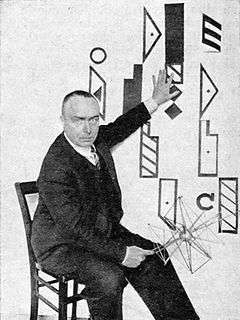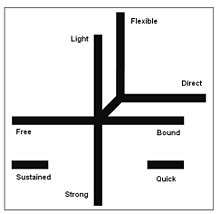Labanotation

Labanotation or Kinetography Laban is a notation system for recording and analyzing human movement that was derived from the work of Rudolf Laban who described it in Schrifttanz (“Written Dance”) in 1928. His initial work has been further developed by Ann Hutchinson Guest and others, and is used as a type of dance notation in other applications including Laban Movement Analysis, robotics and human movement simulation.
Technical standards and education for Labanotation are provided by several organizations. For example, the International Council of Kinetography Laban / Labanotation promotes standards and development for Labanotation. The Dance Notation Bureau has been using Labanotation to document dances since 1940, holding the largest collection of Labanotation scores in the world. It also teaches Labanotation and arranges the staging of dances from the system scores.
History
In the 1920s Rudolf Laban, in collaboration with colleagues, developed a notation system that could be used to describe movement in terms of spatial models and concepts. This contrasts with other movement notation systems based on anatomical analysis, letter codes, stick figures, music notes, foot tracks or word notes. The system precisely and accurately portrays temporal patterns, actions, floor plans, body parts and a three-dimensional use of space. Laban's notation system eventually evolved into modern-day Labanotation and Kinetography Laban.
Labanotation and Kinetography Laban evolved separately in the 1930s through 1950s, Labanotation in the United States and England, and Kinetography in Germany and other European countries. As a result of their different evolutionary paths, Kinetography Laban hasn't changed significantly since inception, whereas Labanotation evolved over time to meet new needs. For example, at the behest of members of the Dance Notation Bureau, the Labanotation system was expanded to allow it to convey the motivation or meaning behind movements. Kinetography Laban practitioners, on the other hand, tend to work within the constraints of the existing notation system, using spatial description alone to describe movement.[1]
The International Council of Kinetography Laban was created in 1959 to clarify, standardize and eliminate differences between Labanotation and Kinetography Laban. Thanks to this, one or both are currently used throughout the world almost interchangeably, and are readable to practitioners of either system.
Principal concepts
Labanotation uses abstract symbols to define the:
- Direction and level of the movement
- Part of the body doing the movement
- Duration of the movement[2]
- Dynamic quality of the movement
Direction and level of the movement
The shapes of the direction symbols indicate nine different directions in space and the shading of the symbol specifies the level of the movement.
Each "direction symbol" indicates the orientation of a line between the proximal and distal points of a body part or a limb.[3] That is, "the direction signs indicate the direction towards which the limbs must incline". [4]
The direction symbols are organized as three levels: high, middle, and low (or deep):
| Labanotation direction symbols | |||||||
|---|---|---|---|---|---|---|---|
| (Hover mouse over symbols to see their names) | |||||||
| High Level | left-forward-high | forward-high | right-forward-high | ||||
| left-high | place-high | right-high | |||||
| left-back-high | back-high | right-back-high | |||||
| Middle Level | left-forward-middle | forward-middle | right-forward-middle | ||||
| left-middle | place-middle | right-middle | |||||
| left-back-middle | back-middle | right-back-middle | |||||
| Low Level | left-forward-Low | forward-Low | right-forward-Low | ||||
| left-Low | place-Low | right-Low | |||||
| left-back-Low | back-Low | right-back-Low | |||||
Part of the body doing the movement
Labanotation is a record of the facts, the framework of the movement, so that it can be reproduced.
The symbols are placed on a vertical staff, the horizontal dimension of the staff represents the symmetry of the body, and the vertical dimension represents time passing by.
The location of a symbol on the staff defines the body part it represents. The centre line of the staff represents the centre line of the body, symbols on the right represent the right side of the body, symbols on the left, the left side.
Duration of the movement
The staff is read from bottom to top and the length of a symbol defines the duration of the movement. Drawing on western music notation, Labanotation uses bar lines to mark the measures and double bar lines at the start and end of the movement score. The starting position of the dancer can be given before the double bar lines at the start of the score.
Movement is indicated as "the transition from one point to the next", that is as one "directional destination" to the next.[5]
Spatial distance, spatial relationships, transference of weight, centre of weight, turns, body parts, paths, and floor plans can all be notated by specific symbols. Jumps are indicated by an absence of any symbol in the support column, indicating that no part of the body is touching the floor.
Dynamic quality of the movement

The dynamic quality is often indicated through the use of effort signs (see Laban Movement Analysis).
The four effort categories are[6]
- Space: Direct / Indirect
- Weight: Strong / Light
- Time: Sudden / Sustained
- Flow: Bound / Free
Dynamics in Labanotation are also indicated through a set of symbols indicating a rise or lowering of energy resulting from physical or emotional needs, e.g. physically forceful versus an intense emotional state.
Motif Notation
Motif Description, or the preferred term "Motif Notation", is closely related to Labanotation in its use of the same family of symbols and terminology. Labanotation is used for a literal, detailed description of movement so it can be reproduced as it was created or performed. In contrast, Motif Notation highlights core elements and leitmotifs depicting the overall structure or essential elements of a movement sequence. It can be used to set a structure for dance improvisation or for an educational exploration of movement concepts. Not limited to dance, Motif Notation can be used to direct one's focus when learning to swing a golf club, the primary features of a character in a play, or the intent of a person's movement in a therapy session.
References
- ↑ Interview with Ann Hutchinson Guest (August, 2012).
- ↑ "Handbook for Laban Movement Analysis" Written and Compiled by Janis Pforsich. copyright Janis Pforsich 1977
- ↑ Hutchinson, Ann. Labanotation or Kinetography Laban: The System of Analyzing and Recording Movement (1954, 1970, 1977). New York: Theatre Arts Books. pp. 164-170.
- ↑ Knust, Albrecht. Dictionary of Kinetography Laban (Labanotation); Volume I (1979). Plymouth: MacDonald and Evans. p. 14
- ↑ Hutchinson, Ann. Labanotation or Kinetography Laban: The System of Analyzing and Recording Movement (1954, 1970, 1977). New York: Theatre Arts Books. pp. 15, 29.
- ↑ Laban, Rudolf, and Lawrence, F. C. Effort. (1947). London: MacDonald and Evans.
Further reading
- Hutchinson-Guest, Ann. (1970). Labanotation: The System of Analyzing and Recording Movement. 4th revised edition (2005). New York: Theatre Arts Books. (First published 1954).
- Hutchinson-Guest, Ann. (1983). Your Move: A New Approach to the Study of Movement and Dance. New York: Gordon and Breach.
- Hutchinson-Guest, Ann. (1989). Choreo-Graphics; A Comparison of Dance Notation Systems from the Fifteenth Century to the Present. New York: Gordon and Breach.
- Knust, Albrecht. (1948a). The development of the Laban kinetography (part I). Movement. 1 (1): 28–29.
- Knust, Albrecht. (1948b). The development of the Laban kinetography (part II). Movement. 1 (2): 27-28.
- Knust, Albrecht. (1979a). Dictionary of Kinetography Laban (Labanotation); Volume I: Text. Translated by A. Knust, D. Baddeley-Lang, S. Archbutt, and I. Wachtel. Plymouth: MacDonald and Evans.
- Knust, Albrecht. (1979b). Dictionary of Kinetography Laban (Labanotation); Volume II: Examples. Translated by A. Knust, D. Baddeley-Lang, S. Archbutt, and I. Wachtel. Plymouth: MacDonald and Evans.
- Laban, Rudolf (1975). Laban’s Principles of Dance and Movement Notation. 2nd edition edited and annotated by Roderyk Lange. London: MacDonald and Evans. (First published 1956.)
- Laban, Rudoph. (1928). Schrifttanz. Wein: Universal.
- Preston-Dunlop, V. (1969). Practical Kinetography Laban. London: MacDonald and Evans.
External links
- Dance Notation Bureau website
- International Council of Kinetography Laban website
- Laban Lab (learn the basics of Labanotation)
- Free Labanotation editing software
- LabanWriter (Mac OS)
- KineScribe (iPad)